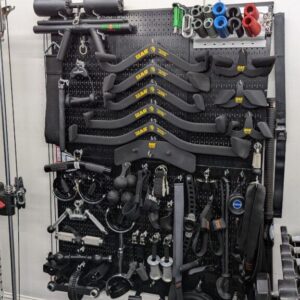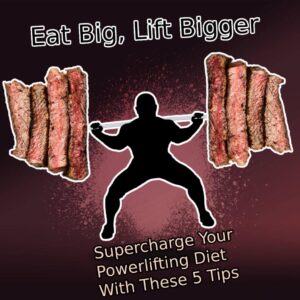Knee Wraps 101: An Intro to Powerlifting Bondage
Hi, hello, and welcome to another informational segment brought to you by me (Manda Wolff). Today’s topic is for those of you who enjoy squatting, want to overload on your squats, or have decided that squats are missing a certain level of spice. Enter, Knee Wraps.
Who is Manda?

Manda is the GGC Resident Expert Powerlifter. She is a top 5 finisher in the female category for the past several years in the GGC, has competed in four federations, judged for four federations, and has attended more meets than she can keep track of.
She wrote our GGC vs a “Real Meet” series which dives into stepping onto the platform and what that looks like.
Enough rambling… let’s let Manda do her thing.
Table of Contents
Key Notes
The 4 Best Ways To Improve Your Recovery For Powerlifters are through Training Within Your MRV, Improving Passing Recovery, Nailing Your Nutrition, and sprinkling in some Active Recovery Tools.
Transparency Note
Some of the items and links in this article might be affiliate links, or might be linked to a Sponsor of the Garage Gym Competition. These links and sponsorships help fund the website, the competition itself, the newsletter, non-profit donations, and everything else we do FOR FREE here at the GGC. I like to be transparent so you know what is up. I appreciate the support if you choose to use the links.
The Difference Between Sleeves and Knee Wraps

Knee sleeves are the most commonly used lifting gear for squats. They’re easy. You pull them over your knees and can begin activity. They are designed to keep your knee joint warm, provide some stability, and can even reduce pain. They typically allow for full ROM without too much hassle. Wraps are designed not to keep your joints warm, but to immobilize the knee joint. They provide even more stability to the knee joint, as you can wrap as tightly as physically possible. This allows the lifter to get more “pop” out of the hole and handle more weight.
Who Should Use Knee Wraps?
I’m going to put this bluntly, because wraps are not for everyone. If your squat pattern is not near perfect, wraps are not for you. Especially not if you’re trying for max weight. Knee Wraps can make depth problems and other technique issues MUCH worse.
If you can’t hit depth in sleeves, you will not be able to force yourself into the hole with wraps. If your hips shoot out coming out of the hole, wraps will be a detriment. You will end up making this problem WORSE with every squat you attempt.
Once the wraps have done their job getting you out of the hole, they will continue to contract to straighten your leg. Pushing your knees back out, while possible, will not be easy. If you are comfortable squatting at least 1.5X your body weight for a good 2-3 reps with good form, introducing yourself to wraps could be a good idea to get your squat to the next level.
Note: If you have patellar tendonitis/ pain, and are planning to use a LIGHT wrap to wrap around the patellar tendon as a means of compression, this does not apply. If you wrap loose enough that you can bend your knee in a seated position, UNLOADED, your squat pattern should remain mostly unaffected. We are talking about TIGHT wraps for the sake of pushing big PRs.

When Should I Use Knee Wraps?
As I mentioned earlier, wraps should be used either when you have patellar tendon pain that can be eased with compression (light wrap), or when you are a competent squatter who wants to push the envelope (medium to heavy wrap). If you are the latter, my professional advice is to squat as much in sleeves as possible to build strength in your quads and knee joints, and introduce wraps 6-8 weeks out from a competition.
If you are not competing in a sanctioned meet, and want to introduce wraps, the same applies. Give yourself a good 6 to 8 weeks in a wrap cycle to work up to a 1 rep max, and then back to sleeved work. The tendons and ligaments in your knees are hindered from developing if you squat in wraps too much, and can lead to more problems down the road. If you already suffer from knee pain, extended use of wraps over the kneecap could exacerbate that pain. Wraps are a tool, not a solution.
Which Knee Wraps Should I Use?
So, you’ve decided to venture into the world of wraps. It would take the rest of my life to tell you about all of the different wraps out there, but I can break them down into two categories: Rebound and Stopping Power. The stretchier the wrap material, the more rebound you will have out of the hole. The thicker the wrap, the more stopping power. Thick wraps may also be phrased as cast wraps, which means they act like a cast. You stand up, they shrink down. Highly effective if you can handle the associated pain. (You can assume then that a thick, stretchy wrap will have both decent rebound and stopping power).
In my experience, close stance squatters have better experiences with wraps that provide more rebound, while wide stance squatters fare better with wraps that prioritize stopping power, due to the amount of knee flexion that varies between the two styles of squat. Keep in mind this is highly subjective, and each lifter will have to experiment to see which wraps work best for them. To date, I’ve tried no less than 30 different pairs of wraps to find the “perfect” ones for competition.
Lengths
Knee wraps come in three lengths: 2M, 2.5M, and 3M. If you’re a small lifter, 2M may be enough. If you’re a large human, 3M may be for you. Most powerlifting federations have a 2.5M limit, but check the rulebook before you purchase. If you can comfortably get 4 revolutions around your knee with 2.5M, there is no need for 3M. More is not always better.
If you are a lifter who wishes to use wraps to keep their joints warm, and won’t be using them to crank around your legs, there are a few companies out there that make velcro knee wraps. You can easily put them on and take them off in between sets without burning out your forearms. For most sanctioned meets, velcro wraps will not be allowed, and you will either want to have someone wrap you, or become proficient at self wrapping. Which brings us to…
How to Wrap
If you are self wrapping, pre stretching your wraps is fine. This means to use a wrap roller (or the stand and pull) method, to stretch and roll up your wraps for use. If they are pre stretched, that’s less pulling you have to do while wrapping, and less work for your forearms. There are many ways to wrap, and there are hundreds of videos online, but here are two of the most commonly used methods.
Basic Knee Wrap Tutorial
Joe is one of the best squatters in the powerlifting world. At about 2 minutes in, he goes over the most basic self wrap. Pay close attention to the points where he pulls on the wraps to tighten them BEHIND the knee, and not ACROSS the kneecap. We don’t want our patellas moving.
The Criss Cross or X Method
This is my favorite way to wrap.
Notes From Joe Gray on Knee Wraps
Manda’s notes above are SOLID about the knee pain problem. I squatted with wraps for a few years and had bad knee pain. It wasn’t until I went back to sleeves and fixed my issues that my knee pain went away. I’m planning to introduce wraps again in the near future, but in the same way Manda mentions above.
Another item I get asked regularly, is how much wraps can improve your squat. I found for me they added roughly 100lbs to my squat. So for reference, I could squat in sleeves about 450lbs, and wraps 550lbs. With a new 505lb sleeved squat, I would expect to approach the 600lb mark in wraps in the future.
Another item to consider is that wrapping takes additional time. When I wrap, my squat workouts take FOREVER, especially if you are doing multiple working sets of wrapped squats. You have to wrap them around you, get set, lift, take them off, cool down, wrap them up, and rinse and repeat. Expect an extra 30 minutes for your workout.
Conclusion (From Manda)
Knee wraps are a different animal. Competition level wrapping can leave you bruised, bleeding, or scarred. The good thing here though, is you do not need to wrap that tightly every time, nor would I recommend it if you are not attempting max weights. They can help mitigate knee pain, as well as help add pounds onto your squat. If you’re a lifter that is ready to step into the world of knee bondage, I welcome you, and hope you have fun.
Looking for wraps? some of our sponsors such as Pioneer and Cerberus Strength sell them.
If you have additional requests or clarifications on wraps, or would like to request another article from our resident expert Manda, drop a comment or hit us up.
📌Enjoy Powerlifting? Want to enter a FREE competition with thousands of dollars in prizes and donations to non-profits? Check out our next event!
🏅 Own a home gym? Like to save money? Check out my full list of discount codes.



